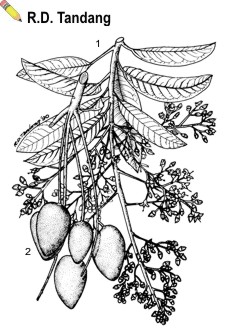Record Number
1520
PROSEA Handbook Number
2: Edible fruits and nuts
Taxon
Mangifera altissima Blanco
Protologue
Flora de Filipinas: 181 (1837).
Family
ANACARDIACEAE
Chromosome Numbers
2n = 40
Synonyms
Mangifera rumphii Pierre (1897), Buchanania reticulata Elmer (1912), Mangifera merrilli Mukherji (1949).
Vernacular Names
Indonesia: medang kok, membacang. Papua New Guinea: wel mango (Pidgin). Philippines: paho, pahutan (Tagalog, Bisaya), pangamangaen (Ilokano).
Origin and Geographic Distribution
Mangifera altissima is native to the Solomon Islands, New Britain, New Guinea (west and north), Moluccas, Sulawesi, Lesser Sunda Islands and the Philippines (Luzon to Mindoro). In the Philippines it is also found in backyards, sometimes in appreciable numbers.
Uses
In the Philippines the immature fruit is eaten fresh, pickled or mixed with vegetables. In Indonesia the ripe fruits are eaten or used to prepare marmalade; the seeds are salted and pounded to obtain an edible meal. The wood is used for general construction work and indoor woodwork, but is not very durable.
Production and International Trade
The fruit appears on local markets. In the Philippines the wood is available in small quantities.
Properties
The edible portion comprises about 75% of the fruit and contains per 100 g: water 82 g, protein 0.7 g, fat 0.6 g, carbohydrates 16.4 g, fibre 2.3 g, ash 0.5 g, calcium 95 mg, phosphorus 17 mg, iron 1.2 mg, vitamin A 131 IU, thiamine 0.06 mg, riboflavin 0.1 mg, niacin 0.4 mg, vitamin C 93 mg. The energy value is about 277 kJ per 100 g. The wood seasons well, is easy to work and takes a beautiful polish. The heartwood is durable for interior work but very perishable when in contact with the ground. The sapwood is very susceptible to damage by dry-wood termites.
Botany
Erect, evergreen tree, 12—35(—54) m tall, trunk 35—80(—100) cm diameter, with angular branchlets and prominent leaf scars. Leaves elliptic to oblong-lanceolate, (5—)15—43 cm x 2—11 cm, coriaceous, glabrous, dark green above; base cuneate, margins entire; apex acuminate, mucronate or obtuse; midrib and nerves prominent, veins reticulate; petiole 1.5—5(—9) cm long. Inflorescences terminal or axillary panicles, crowded at apex of twigs, 10—25 cm long, glabrescent; pedicels up to ca. 1 mm long; flowers white or creamy white, in groups of 4—5 on secondary branches, male or bisexual; bracts triangular; calyx 4-lobed, lobes ovate-oblong, 1.5—3 mm long, glabrescent, persistent; petals 4, ovate-oblong, 3—5 mm long, glabrous; disk 4-lobed and papillose; stamens 5, 1 fertile, free, 2—3 mm long; style 2—3 mm long, excentric. Fruit an ellipsoid to ovoid drupe, 5—8 cm x 3—6 cm, weight about 40 g, green turning yellowish; peel tender, up to 1.7 mm thick; flesh slightly fibrous, white, resinous, acid to slightly sweet. Stone 4.2—4.8 cm x 2.3—2.7 cm x 0.8—1.5 cm, sparsely fibrous.
In New Guinea the tree flowers in November—December. In the Philippines main flowering is early in the dry season (October—November to January—February), but flowers and fruits can be found the whole year round. Male and bisexual flowers both occur in the same inflorescence. Fruits are harvestable about 70 days from full bloom and ripen within 6 days.
In New Guinea the tree flowers in November—December. In the Philippines main flowering is early in the dry season (October—November to January—February), but flowers and fruits can be found the whole year round. Male and bisexual flowers both occur in the same inflorescence. Fruits are harvestable about 70 days from full bloom and ripen within 6 days.
Image
 | Mangifera altissima Blanco - 1, flowering branch; 2, branch with fruits |
Ecology
Mangifera altissima grows chiefly in primary, lowland, inland forest, sometimes in coastal forest, rarely up to 400 m altitude. In the Philippines it thrives in places with a distinct wet and dry season on a wide range of soil types.
Agronomy
Mangifera altissima is usually propagated by seed, although it can be readily propagated by cleft grafting, using either seedlings of mango or Mangifera altissima as a rootstock. Grafted Mangifera altissima trees remain much smaller and have a more compact crown than seedling trees. Unlike the mango, flowering in Mangifera altissima cannot be brought about by foliar spraying with potassium nitrate. Typical mango pests such as leaf hoppers, tip borers and seed borers do not seem to affect Mangifera altissima.
Genetic Resources and Breeding
A germplasm collection of Mangifera altissima is present at the Institute of Plant Breeding, UPLB, Los Baños, the Philippines. More accessions from the entire area of distribution are needed.
Prospects
Mangifera altissima occurs mainly in areas with distinct dry and wet seasons, where it has only a modest place, because of the dominance of the mango.
Literature
Bondad, N.D. et al., 1979. Observations on the panicles and fruits of Mangifera altissima. Kalikasan, Philippine Journal of Biology 8: 79—92.
Ding Hou, 1978. Anacardiaceae. Mangifera L. In: van Steenis, C.G.G.J. (Editor): Flora Malesiana. Series 1. Vol. 8. p. 430.
Villegas, V.N., 1979. The cytology and floral morphology of some Philippine Mangifera indica L. cultivars and Mangifera altissima Blanco. MSc Thesis, University of the Philippines, Los Baños, Laguna, the Philippines. 58 pp.
Ding Hou, 1978. Anacardiaceae. Mangifera L. In: van Steenis, C.G.G.J. (Editor): Flora Malesiana. Series 1. Vol. 8. p. 430.
Villegas, V.N., 1979. The cytology and floral morphology of some Philippine Mangifera indica L. cultivars and Mangifera altissima Blanco. MSc Thesis, University of the Philippines, Los Baños, Laguna, the Philippines. 58 pp.
Author(s)
D.E. Angeles
Correct Citation of this Article
Angeles, D.E., 1991. Mangifera altissima Blanco. In: Verheij, E.W.M. and Coronel, R.E. (Editors): Plant Resources of South-East Asia No 2: Edible fruits and nuts. PROSEA Foundation, Bogor, Indonesia. Database record: prota4u.org/prosea

All texts are licensed under a Creative Commons Attribution-Noncommercial-Share Alike 3.0 Netherlands License
This license does not include the illustrations (Maps,drawings,pictures); these remain all under copyright.